Keywords
|
| wireless sensor network, sensor node, security, attacks, cluster, Data Aggregation. |
INTRODUCTION
|
| The Sensor Network can be described as a collection of sensor nodes which co-ordinate to perform some specific action. Unlike traditional networks, sensor networks depend on dense deployment and co-ordination to carry out their tasks. Sensor Networks consisted of small number of sensor nodes that were wired to a central processing station. However, nowadays, the focus is more on Wireless Sensor Networks. |
| In Figure 1 shows Wireless Sensor Network Architecture. Wireless sensor networks are consisting of numerous light weight and tiny sensor nodes with limited power, storage, communication and computation capabilities. Wireless sensor networks are being employed in civilian applications like habitat monitoring to mission critical Applications. |
| A sensor node is made up of four basic components as shown in Figure 2 a sensing unit, a processing unit, a transceiver unit and a power unit. They may also have application dependent additional components such as a location finding system, a power generator and a mobilizerUsers. |
GENERAL SURVEY OF WIRELESS SENSOR NETWORKS (WSNS)
|
| Several attempts were made by the researchers to study the major challenges in WSNs, security requirements of WSNs, Constraints of WSNs. That survey mentions in below Table 1. |
DATA AGGREGATION
|
| The architecture of the sensor network plays important role in the performance of data aggregation protocols. Several data aggregation protocols have been proposed .These protocols can be classified based on network models. There are two categories: Tree based data aggregation [9] and cluster based data aggregation. |
| Cluster based Data aggregation [8] is the process of combining the data coming from various sources and en route them after removing redundancy such as to improve the overall network lifetime. The in-network processing is done on the aggregator node. The aggregator node aggregate the data received from its child node as per the required aggregation function (like min, max, average, sum etc.) and send the aggregated result to the other high level aggregated node. |
| An Aggregation Scenario using Clustering shown in Figure 3 in that cluster heads collect the data from all the neighbours sensor nodes and forwarded that data to the Base Station (Sink Node).Base station sends that information to the external network via Internet. |
CLASSIFICATION OF SECURE DATA AGGREGATION
|
| The work on secure data aggregation can be classified based on encryption of data at specific nodes into three categories, hop-by-hop encrypted data aggregation end-to-end encrypted data aggregation [12] and Privacy Homomorphism. |
| A. Hop-by-Hop encrypted data aggregation |
| In the hop-by-hop encrypted data aggregation [13], intermediate nodes decrypt every message received by them. so, get the plaintext .Then aggregate the plaintext according to the aggregate function, and encrypt the aggregate result before transmitting it. In this all the intermediate sensor node has to decrypt the received data and apply aggregation function on it. Due to many decryptions perform by the intermediate node it’s consuming more battery power and not provide end-to-end security. |
| B. End-to-End encrypted data aggregation |
| In order to overcome the drawbacks of the hop-by-hop encrypted data aggregation [14, 15, 17] a set of end-to-end encrypted data aggregation protocols are proposed. In those schemes, intermediate nodes can aggregate the cipher text directly without decrypting the messages. Compared to the hop-by-hop one, it can guarantee the end-to-end data confidentiality and result in less transmission latency and computation cost. Adversaries will not be able to recognize what reading it is during data transmission. In terms of privacy, they designed aims to eliminate redundant reading for data aggregating but this reading remains secret to the aggregator. |
| C. Privacy Homomorphism |
| A Privacy Homomorphism (PH) [18] is an encryption transformation that allows direct computation on encrypted data. In homomorphic encryption certain aggregation functions can be calculated on the encrypted data. The data is encrypted and sent toward the base station, while sensors along the path apply the aggregation function on the encrypted data. The base station receives the encrypted aggregate result and decrypts it. Specifically, a homomorphic encryption scheme allows the following property to hold |
| enc (a + b) = enc (a) + enc (b) |
| This means that in order to calculate the SUM of two values, we can apply some function to their encrypted counterparts and then decrypt the result of the SUM operation at sink node. The data would be encrypted at the sensor node, the SUM or AVERAGE would be calculated as the aggregate result follows a path to the base station, and the final result would be decrypted at the base station. |
A GENERAL FRAMEWORK OF SECURE DATA AGGREGATION IN WIRELESS SENSOR NETWORK
|
| In a general framework of Secure Data Aggregation, First, we discuss about the how to make clusters for the randomly placed nodes using Heartbeat node placement algorithm. We modify Appheartbeat protocol for the implementation of the clustering for the Data Aggregation. For the simulation we use Jist (java in simulation time)/SWAN (Scalable Wireless Ad-hoc Networks) Simulator. |
| Some of the nodes will work as cluster heads. These cluster heads are responsible to receive message or data from their neighbours. Each cluster head send hello message to all other nodes, those nodes which are in the range of cluster head they send the message back to cluster head and join with that cluster for further processing. We measure energy usage by every cluster head by the energy model which is integrated in the SWAN simulator and also show the comparison graph of energy usage by clusters heads between static and dynamic clusters heads selection procedure. |
| In below figure we mention the steps for the Data Aggregation using cluster based Data Aggregation for that we modify Apphertbeat protocol which is my default protocol given in SWAN simulator. |
| We apply privacy on sending data by the sensor nodes to the Cluster head. We apply end to end symmetric cryptography based on Privacy Homomorphism on the sending data. |
| Figure 5 represents End to End privacy approach, in that S1, S2, ..., Sn. nodes sense the data from the environment, before sending it to cluster head or aggregator node, It they apply encryption method on it and then send encrypted data to the cluster head. Perform SUM function on encrypted data using Privacy Homomorphism and sends this encrypted aggregated result to the base station. Base station applies decryption method on that data and gets original data. During this whole procedure we measure the energy usage by the cluster heads. |
CONCLUSION
|
| By reviewing the existing data aggregation in the WSN, an adversarial model that can be more useful to save the energy of Wireless sensor Nodes that lead to improve the life time of whole networks. An adversarial model for security on Data Aggregation its help us to give batter performance compare to existing scheme. |
FUTURE WORK
|
| In future work, this method can be made more scalable and finetuned with the multi level clustering where the cluster can have two to three level tree so the cluster can cover more number of nodes with lower energy consumption. It is also planned to evaluate more secure schemes and extend the framework if necessary. We hope that our work will encourage other researchers to consider the vital problem of secure information aggregation in sensor networks. |
Tables at a glance
|
 |
| Table 1 |
|
| |
Figures at a glance
|
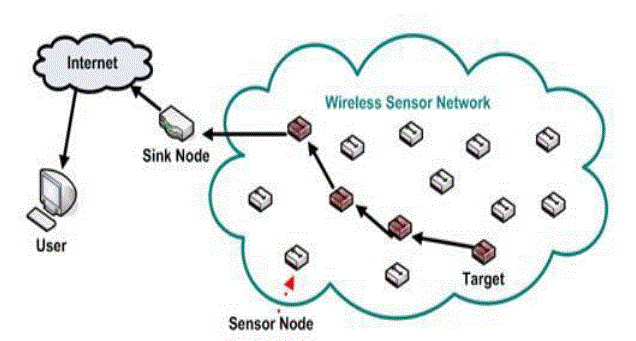 |
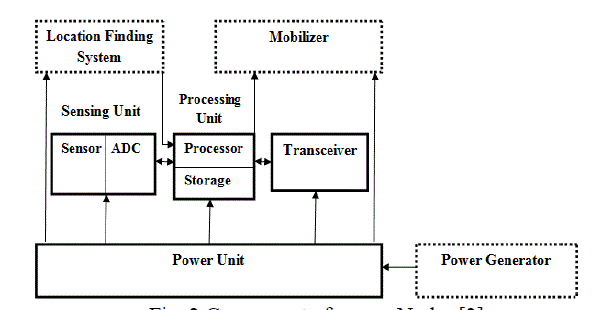 |
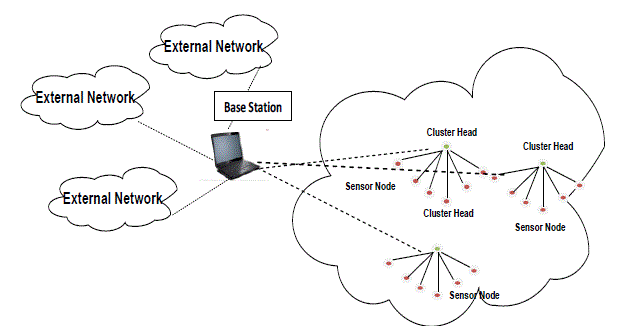 |
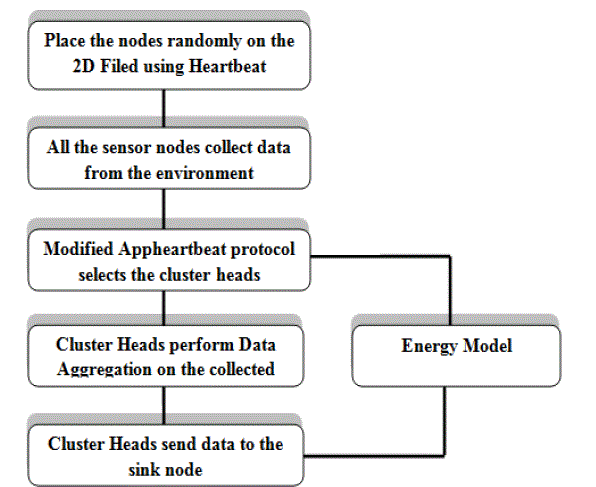 |
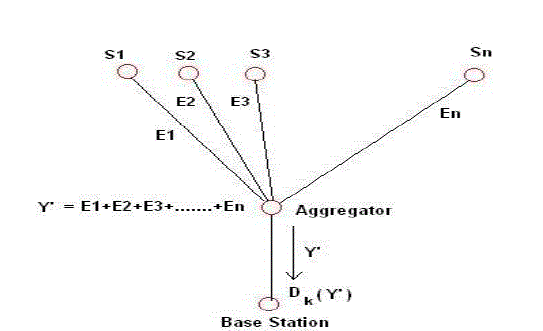 |
| Figure 1 |
Figure 2 |
Figure 3 |
Figure 4 |
Figure 5 |
|
| |
References
|
- Akyildiz, I.F. Weilian Su Sankarasubramaniam, Y. Cayirci, E. Georgia , ”A survey on sensor networks “, IEEE communicationmagazine,Vol.30,No.8,pp. 102 – 114, 2002.
- Xiangqian Chen, Kia Makki, Kang Yen, and NikiPissinou, ” Sensor Network Security: A Survey”, IEEE Communications Surveys &Tutorials, Vol. 11, No. 2, Second Quarter, 2009.
- 3 I.F. Akyildiz, W. Su*, Y. Sankarasubramaniam, E. Cayirci,”Wireless sensor networks: a survey”, Computer Networks, volume 38 ,pp. 393–422,2002.
- Yong Wang, GarhanAttebury, and ByravRamamurthy,”A Survey Of Security Issues In Wireless Sensor Networks”, IEEE Communication ,2nd quarter, volume 8, NO. 2,2006.
- Hemanta Kumar Kalita and AvijitKar, “Wireless Sensor Network Security Analysis”, International Journal of Next-Generation Networks(IJNGN), Vol.1, No.1, December 2009..
- Jennifer Yick, Biswanath Mukherjee, Dipak Ghosal,”Wireless sensor network survey”,Computer Networks ,vol. 52 ,pp. 2292–2330,2008.
- Xiangqian Chen, Kia Makki, Kang Yen, and NikiPissinou,”Sensor Network Security: A Survey”,Ieee Communications Surveys & Tutorials,Vol. 11, No. 2, pp 55-77,second quarter 2009,
- Mukesh Kumar Jha, T.P. Sharma,“Secure Data aggregation in Wireless Sensor Network: A Survey”, Computer Networks,2005.
- Elena Fasolo and Michele Rossi,“Network Aggregation Techniques For Wireless Sensor Networks: A Survey”, Ieee WirelessCommunications , April 2007.
- Hani Alzaid Ernest Foo Juan Gonzalez Nieto,” Secure Data Aggregation in Wireless Sensor Network: a survey”, Conferences in Research andPractice in Information Technology (CRPIT), Vol. 81, January 2008.
- Nandini. S. Patil, Prof. P. R. Patil, “Data Aggregation in Wireless Sensor Network”, IEEE International Conference on ComputationalIntelligence and Computing Research, 2010.
- Yingpeng Sang, Hong Shen, “Secure Data Aggregation inWireless Sensor Networks: A Survey”, Proceedings of the Seventh InternationalConference on Parallel and Distributed Computing, Applications and Technologies (PDCAT'06), 2006.
- Xiaoyan Wang , Jie Li, XiaoningPeng And BeijiZou,”Secure And Efficient Data Aggregation For Wireless Sensor Networks”, IEEE Seventhvehicular Technology Conference Fall ,pp. 1-5, 2010.
- C.Castelluccia, E.Mykletun, G.Tsudik,”Efficient Aggregation of Encrypted data in wireless sensor network”, in: Proceeding of the conferenceon mobile and Ubiquitous System: Networking and Services, pp.109-117, 2005.
- D. Westhoff, J. Girao, M. Acharya,“Concealed Data Aggregation for Reverse Multicast Traffic in Sensor Networks: Encryption, Key Distributionand Routing Adaptation”, IEEE Transactions on Mobile Computing, Vol. 5, No. 10, pp. 1417-1431, 2006.
- Shih-I Huang, Shiuhpyngshieh, J.D.Tygar,“Secure encrypted data aggregation for wireless sensor networks”, Springer, 2009.
- A.S.Poornima, B.Amberker,”SEEDA: Secure End to End data Aggregation in Wireless sensor networks”, IEEE Seventh InternationalConference on Wireless and Optical Communication Network,pp.1-5, 2010.
- Josep Ferrer and Domingo, “A new privacy homomorphism and applications”, In: Inf. Process. Lett.60(5), pp. 277–282, 1996.
|